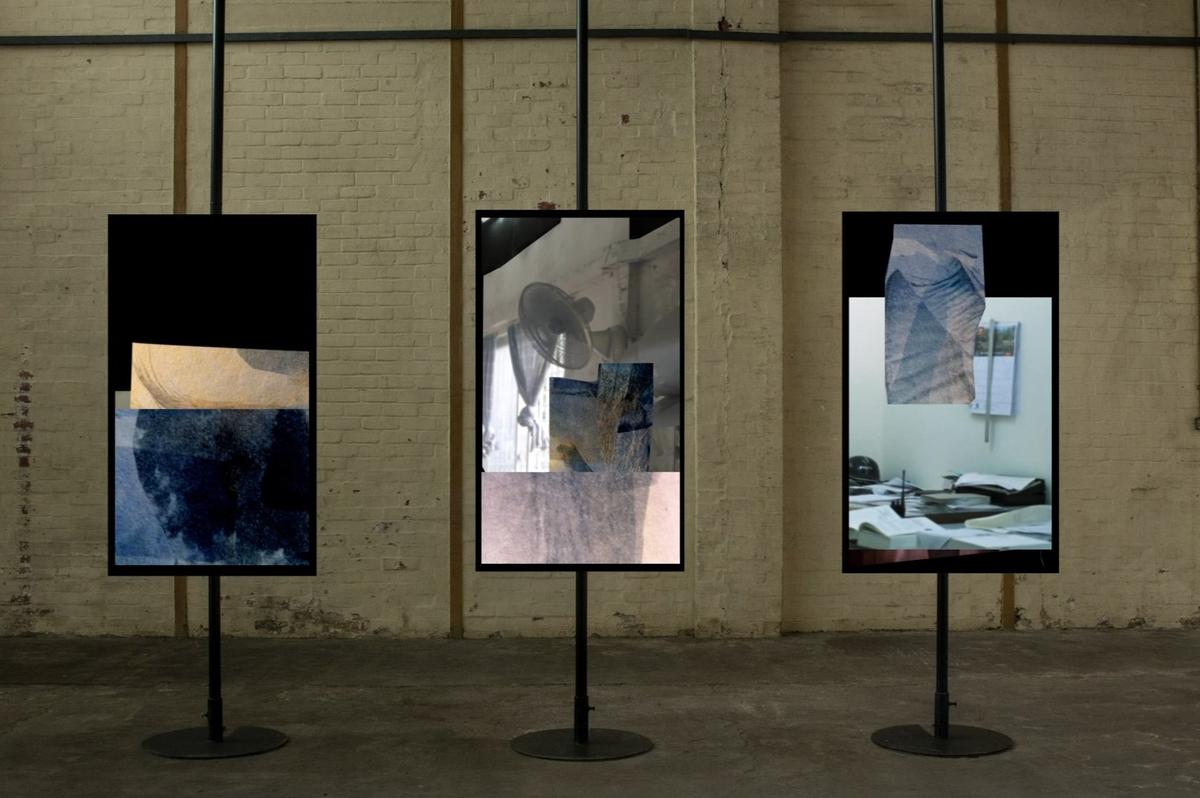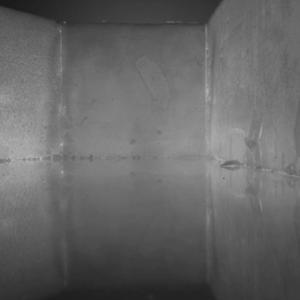There are two kinds of sleeping— to lapse into cool night hours, a patron of one’s own Circadian rhythm, and the second kind, snatched and heady. Sonya Lacey’s Pillows at Paludal, Ōtautahi, is balanced between. Its premise is falling asleep conspicuously, in someplace undesigned for rest. But Lacey doesn’t fall into the circus of hallucinatory sleep. The first thing I notice of the work is that it is governed by a sense of care. In Simon Palenski’s text for the show, he writes that the work is dedicated to the man who should have been sleeping in it—an image on a reel of footage lost by a customs officer doing their job.
Pillows is a moving image triptych, a three channel work filmed on 16mm, then transferred to digital. There is no audio component to this work, or perhaps there is and it is silence. The absence of sound can be more deliberate than the presence of it. The work is comprised of footage that Lacey gathered while travelling through South-East Asia. I want to say gathered, because what Pillows is comprised of does not feel constructed, but are junctures of space and time that Lacey has accumulated and kept safe on her way. To film while travelling has interesting implications. As a tourist, you are drawn to images which are novel. These images confirm your strangeness in the world. It is not about the place you are visiting, but about your own displacement.
The transit across geographies is not actually visible in Pillows though—it is an external conversation that the accompanying text introduces. The travelling that does happen is to a sleep state, possibly inside someone else’s dream. We can guess we are inside another body because of the breathing: the fluttering pages, a fluster of half-memories. They are not personal, but we are being shown something; we are watching. Lacey has created a work that cradles the viewer—a vehicle away from where we we are—and insomuch, this is travelling. The fact that it is material that has been collected on an actual journey becomes secondary, and this is the great success, that Lacey is able to evoke travel without forcing a difference between here and there. Here, as well, the desk looks idle. The fluid nature of Pillows, made possible by its moving image format, does establish a pathway through time. It squeezes us through this durational moment, stimulating a similar sensation to that of jet lag, drawing attention to where and when we exist. There’s a subtle distinction between air travel and time travel, a magic trick caused by invention and technological advancement. In Pillows, the gap between the two diminishes further.
Installation Shot: Sonya Lacey, Pillows (2020) State of Motion 2020: Rushes of Time, Singapore
A tired fan clicks round and round and round. The repetition of this fills in some sound that is otherwise not there, a low hum of limbo. There is a desk with a thick sheaf of papers quivering on it, perhaps agitated by the fan or an open window somewhere, and what looks like ledgers stacked in rows. Maybe because they are recognisably designed for human interaction and human habits, uninhabited objects often look so self-conscious in their dormancy. They are just waiting. Me, too. The emptiness signals to some industriousness that has not yet eventuated. Its arrival is anticipated though, and so Pillows feels full of drowsy potential—like the idea of rousing oneself in the yawning stretch of afternoon to go for a walk or run—a turning point in the day. In this office, which I think is in a printing factory in Cambodia, the clack-clack of office sounds could begin again at any moment, the end to a dizzy paper lullaby.
These vignettes are spliced with fragments of newspaper. Such newspaper cuttings are characteristic of Lacey’s recent production. They have been washed so that the ink runs and stains the newsprint in indigo and greeny tones. Palenski’s text notes that these are from local newspapers in Pōneke, where Lacey lives. I am not a newspaper subscriber; in fact, I can honestly say I have never purchased a newspaper before. Like many, I read news on a screen and the format is totally changed. Instead of being a vessel for particular stories and current events, the actual page of newspaper is a more general material surface of information. That is, a piece of newspaper drifting across Pillows is an emblem of a shared place, community and imagination. In our participation with the news, we generate and affirm the mechanics of daily routine and structure. We get out of bed, we get dressed, we read the news, we go to work, we know that others around us are doing the same. As Benedict Anderson writes, the newspaper provides the reassurance that the environment that we imagine ourselves living in is visibly rooted in everyday life.(1) By summoning a newspaper from nearby, Lacey grounds Pillows in a reality that we can identify with.
In combining representations of different geographies, the source material of Pillows is able to confirm the sensation of experiencing the work itself—that we are hovering between poles. There is a specific oddity of finding a newspaper out of place. It is a printed document that becomes obsolete so quick that there is no need or desire to disseminate it further than the bounds of its immediate production. The more that I think about this predicament, the more I wonder if the act of publishing occurs in the moment of fixing ink on a page or in its distribution. If printed matter is unable to be found in any wider circulation, is the fact of its publication rendered irrelevant: the "public" root of "publication" negated? Increasingly, we forget about print, newspapers, physical and ephemeral documents. Pillows reverses the roles, so that we remember that more often, we are the unit in motion. The published object might not be as mobile as it used to be, but our mobility is increasing all the time. In the instance where we can no longer board an airplane, it feels as though the foundation of modernity is being undone.
In my mind, the man sleeping in an alternative version of Pillows is still asleep. What Lacey filmed, what is missing visually but woven into the intent of Pillows, is this guy sleeping at his workplace. There are lots of implications we can think of for this action: he is being overworked, his job is boring, he did not get a good sleep the night before. Is it audacious to sleep at work? I think about sleeping as an act of resistance. This is probably the epitome of passive protest, where you claim the space for important functions of human survival in a place— the workplace— that often tries to shrink these needs as small as possible. In a collaborative essay titled Bad Workers: Notes on the Socius and the Book, K. Antranik Cassem writes that “being a bad worker is what it takes to survive.”(2) This is made true in the hidden parts of Pillows, where the man who sleeps has refashioned his workplace into a space of rest, for dreaming. A portal opens up to a place beyond one’s immediate concrete surroundings. Where the portal leads to is what Pillows occupies, and what is left behind is that slowly breathing office. Sleeping on the job inverts the leisure structures that are built into a working day. The regulated window of a lunch break is false rest because it is subjected to the same restrictions and authority of paid working minutes. To sleep on the clock is survival and defiance.
If printed matter is unable to be found in any wider circulation, is the fact of its publication rendered irrelevant: the "public" root of "publication" negated?
Sometimes though, what looks like audacity from the outside can be a personally mundane thing, just an accident of life and insignificant. I don’t mean to dwell on this man sleeping, who is never seen, but Lacey keeps him safe. He can nap inconsequentially, be someone who is tired and nothing more, through his circumstantial anonymity. I watch a video of a book getting made. It is a communal activity, a group of people perform a choreography in order to collate the pages. Surely, this labour of bodies, a physical exercise, cannot be completely obscured by the bound book. I feel that the man sleeping must be embodied somewhere in the papers he rests on. Thus, although the printing of history and the news and important business contracts often do not mention those who set the words in ink on a page, it is nice to imagine these incidents somehow weave their way into such acts of publishing. There are many more people out there like the sleeping man, doing their best too, yet these human interjections into the production of anything are often forgotten. How many documents have been printed to serve firstly as a pillow for a heavy head? I come back to the title, the softness of paper and a cliched affection for the scent of fresh print. I am hopeful that printed matter will always provide comfort, in some sense.
Note: This intended dates for this exhibition were 20 March – 3 April 2020. Due to the Covid-19 the exhibition closed on 24 March. Video and still documentation are from a previous installation as part of State of Motion 2020: Rushes of Time, National Archives of Singapore, 2020

